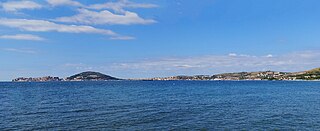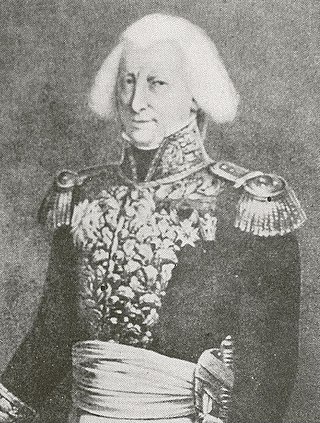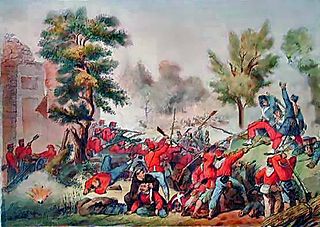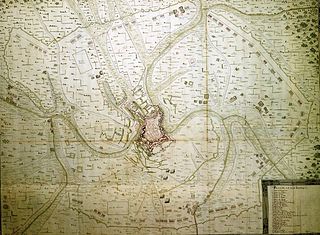
The War of the Polish Succession was a major European conflict sparked by a civil war in the Polish–Lithuanian Commonwealth over the succession to Augustus II the Strong, which the other European powers widened in pursuit of their own national interests. France and Spain, the two Bourbon powers, tested the power of the Austrian Habsburgs in Western Europe, as did the Kingdom of Prussia, whilst Saxony and Russia mobilized to support the eventual victor. The fighting in Poland–Lithuania resulted in the accession of Augustus III, who in addition to Russia and Saxony, was politically supported by the Habsburgs.

Gaeta is a city in the province of Latina, in Lazio, Italy. Set on a promontory stretching towards the Gulf of Gaeta, it is 120 kilometres from Rome and 80 km (50 mi) from Naples.

Otto Ferdinand Graf von Abensperg und Traun, was an Austrian Generalfeldmarschall. The current spelling of the name, and the spelling used in his time, is mostly Abensperg.

Claude-Henri Belgrand de Vaubois was a French general during the French Revolutionary Wars and the Napoleonic Wars. He is best known for the surrender of Malta to the British in 1800. On 20 August 1808 he was created Comte de Belgrand de Vaubois. Later, his name was inscribed on the Arc de Triomphe in Paris.

The Battle of Bitonto was a Spanish victory over Austrian forces near Bitonto in the Kingdom of Naples in the War of Polish Succession. The battle ended organized Austrian resistance outside a small number of fortresses in the kingdom.

The siege of Gaeta was the concluding event of the war between the Kingdom of Sardinia and the Kingdom of the Two Sicilies, part of the unification of Italy. It started on 5 November 1860 and ended on 13 February 1861, and took place in Gaeta, in today's Southern Lazio (Italy).

The Siege of Danzig of 1734 was the Russian encirclement and capture of the Polish city-port of Gdańsk, during the War of Polish Succession. It was the first time that troops of France and Russia had met as foes in the field.
Mignano Monte Lungo is a comune (municipality) in the Province of Caserta in the Italian region Campania, located about 70 kilometres (43 mi) northwest of Naples and about 45 kilometres (28 mi) northwest of Caserta.

The Battle of Goito was fought between the Piedmontese and the Austrian army on 30 May 1848, in the course of the First Italian War of Independence. The Piedmontese army won the battle, as the Austrians were unable to break through to relieve the siege of Peschiera and prevent its surrender which happened on the day before the battle.

The Battle of the Volturno refers to a series of military clashes between Giuseppe Garibaldi's volunteers and the troops of the Kingdom of Two Sicilies occurring around the River Volturno, between the cities of Capua and Caserta in northern Campania, in September and October 1860. The main battle took place on 1 October 1860 between 30,000 Garibaldines and 25,000 Bourbon troops (Neapolitans).

The Battle of Guastalla or Battle of Luzzara was fought on 19 September 1734 between Franco-Sardinian and Austrian (Habsburg) troops as part of the War of the Polish Succession.

The siege of Luxembourg, in which Louis XIV of France laid siege to the Spanish-controlled Fortress of Luxembourg from 27 April to 7 June 1684, was the most significant confrontation of the War of the Reunions between France and Spain. The action caused alarm among France's neighbours and resulted in the formation of the League of Augsburg in 1686. In the ensuing war France was forced to give up the duchy, which was returned to the Habsburgs by the Treaty of Ryswick in 1697.
The Treaty of Casalanza, which ended the Neapolitan War, was signed on 20 May 1815 between the Napoleonic Kingdom of Naples on the one hand and the Austrian Empire, as well as the Great Britain, on the other. The signature occurred in a patrician villa, owned by the Lanza family, in what is now the commune of Pastorano, Campania, southern Italy.

The siege of Gaeta saw the fortress city of Gaeta and its Neapolitan garrison under General Louis of Hesse-Philippsthal besieged by an Imperial French corps led by Marshal André Masséna. After a prolonged defense in which Hesse was severely wounded, Gaeta surrendered, and Masséna granted its garrison generous terms.

The House of Abensberg und Traun is the name of an ancient Austrian noble family, originally from the Upper Austrian Traungau. It is considered one of the oldest extant aristocratic families in Central Europe.
The Army of Naples was a French Army unit which took this name following its capture of Naples in 1799. It was related to the Army of Italy. The Army of Naples was virtually annihilated after the Battle of the Trebbia: more than half of the personnel were casualties.

The siege of Philippsburg was conducted by French forces against troops of the Holy Roman Empire in the fortress of Philippsburg in the Rhine River valley during the War of the Polish Succession. The Duke of Berwick led 100,000 men up the Rhine Valley, of which 60,000 were detached to invest the fortress at Philippsburg, beginning on 26 May 1734. An Imperial relief army of 70,000 under the aging Prince Eugene of Savoy was unsuccessful in actually relieving the siege. On 12 June Berwick was killed by a cannonball while inspecting the trenches, and command of the besiegers fell to Marshals d'Asfeld and Noailles. The fortress surrendered one month later, and the garrison withdrew to the fortress of Mainz with the honours of war.

In the siege of Pamplona, a Spanish force led by Captain General Henry O'Donnell and later Major General Carlos de España blockaded an Imperial French garrison under the command of General of Brigade Louis Pierre Jean Cassan. At first, troops under Arthur Wellesley, Marquess Wellington surrounded the city, but they were soon replaced by Spanish units. In late July 1813, Marshal Nicolas Soult attempted to relieve the city but his operation failed in the Battle of the Pyrenees. Cassan capitulated to the Spanish after the French troops in the city were reduced to starvation. The surrender negotiations were marred by French bluffs to blow up the fortifications and Spanish threats to massacre the garrison, neither of which occurred. Pamplona is located on the Arga River in the province of Navarre in northern Spain. The siege occurred during the Peninsular War, part of the Napoleonic Wars.

The Invasion of Naples was a front during the War of the Third Coalition, in 1806, when an army of the French Empire led by Marshal André Masséna marched from Northern Italy into the Kingdom of Naples, an ally of the Coalition against France ruled by King Ferdinand IV. The Neapolitan army was defeated at Campo Tenese and rapidly disintegrated. The invasion was eventually successful despite some setbacks, including the prolonged Siege of Gaeta, the British victory at Maida, and a stubborn guerrilla war by the peasantry against the French. Total success eluded the French because Ferdinand withdrew to his domain in Sicily, where he was protected by the Royal Navy and a British Army garrison. In 1806, Emperor Napoleon appointed his brother Joseph Bonaparte to rule over Southern Italy as king.

The Army of the Kingdom of Naples was the primary land defence and offence force of the Kingdom of Naples. It served alongside Napoleon’s Grande Armée in various campaigns and wars across Europe, until its final demise in the Neapolitan War of 1815. It was in service from 1806 to 1815, reborn from the Army of the Two Sicilies after the annexation of Naples. The Army was more known for the splendour of its uniforms rather than the achievements of its troops.















